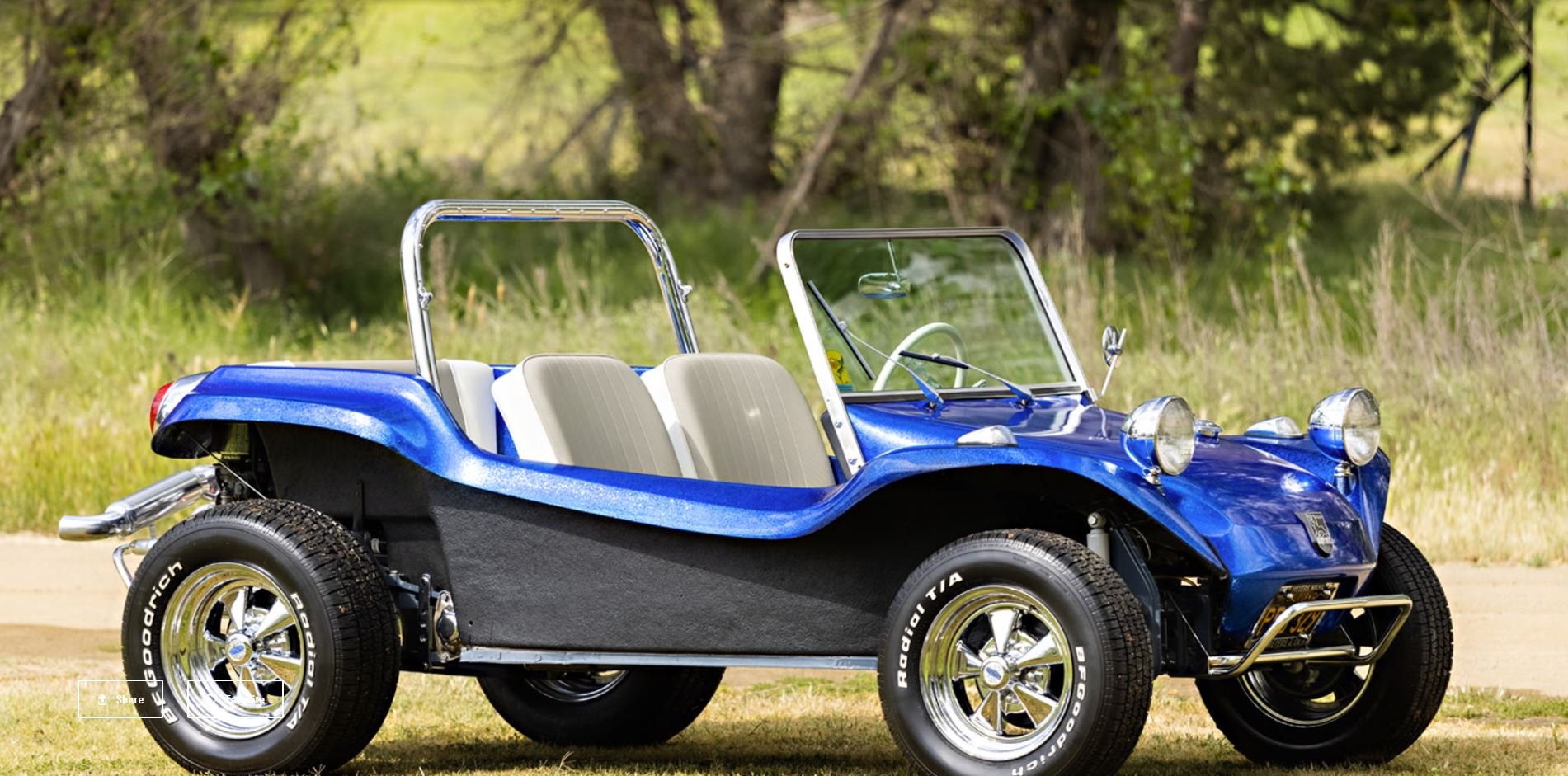1968 Meyers Manx Dune Buggy

Kit car that allowed you the fun and run of your imagination.
This is an early Manx, Chassis # 1436707, one of the first 2,500 produced.
Fitted with many desirable period-correct accessories.
Southern California native Bruce Meyers grew up in the early days of surfing and drag racing. He took his engineering and artistic prowess, inspired by the Pismo Beach dune buggy scene, incorporating his experience building fiberglass boats, and built the first fiberglass-bodied light weight dune buggy, the Meyers Manx.
Bruce Meyers sold Meyers Manx, his namesake dune buggy company in 2020 just months before he died at the age of 94. The new company, Meyers Manx Ltd., has remastered the surviving body moulds and continues to offer the fiberglass-bodied Meyers Manx dune buggy as a kit. A 3-cylinder radial engine, made by Radial Motion, is optional as seen on the prototype here in this exhibit. And, as a newly designed Manx 2.0 Electric Vehicle has entered production.
An article in MotorTrend by Elana Scherr best summarized the Meyers Manx dune buggy history –
“ Meyers started the first Manx in 1963 and completed it in 1964. The car's simple shape belies some rather sophisticated composite work, with embedded steel in a structural, monocoque fiberglass body bolted to the suspension and running gear of a VW Bug. The car was a hit amongst fellow buggy enthusiasts, and received enough media attention (including covers of the Aug. '66 HOT ROD and April '67 Car and Driver) to start orders coming in. Meyers wanted to prove the buggy’s value beyond its good looks.
Meyers and his friends were regular visitors to the wilds of the Baja Peninsula, well before any official races were run there. Honda Motor Co. was using the Tijuana to La Paz route as a publicity stunt to promote its motorcycles, and Meyers and his friend, Ted Mangels, thought they could do the run in less time than the publicized 39 hours and 56 minutes held by bike racer Dave Ekins.
Engines in Manxes range from stock Type 1 VW bug motors to Corvair flat-sixes or modern turbocharged Subaru powerplants. We've even seen V8s. Basically, if you can attach it, you can run it, but the most popular setups seem to be the VW and the Corvair.
The word was out—the Manx was hot, and people wanted it. Meyers had made 12 of the original design before realizing it was unfeasible for mass production. "People didn't really care about the monocoque design," Meyers says. "They just wanted it to be cheap and easy, plus they didn't like throwing away the rest of the VW, and neither did I." The redesigned Manx kit used the chassis of the VW Bug, shortened by approximately 14 inches. Owners used the VW pedal assemblies, shift levers, linkages, transaxle, trailing-arm assemblies, and engine as well as whatever gauges, seats, steering wheel, and other pieces they desired from the donor bug or from many buggy accessory catalogs available at the time.
A complete kit was advertised as including a bodyshell, decklid, dashboard, windshield, headlight housing, cowl frame, rear deck cover, aluminum trim, weatherstripping, fender wells, and all hardware. Finding a donor Beetle was up to you.
Costing about $600 plus a wrecked VW, the Meyers Manx was a good deal, maybe too good. Meyers was cranking them out and had dealers all over the country, but his process was labor intensive, and several companies, some with less stringent quality control, began marketing their own version of the fiberglass dune buggy, often straight-up copies of Meyers' design. There were court cases and attempts to waylay the Manx forgers through increasingly complex mold-making designs like the all-off-road Tow'd and the radical, scissor-doored Manx SR, but the court cases went against Meyers, and the Tow'd and the SR did not have the mass appeal, nor ease of assembly, that made the original Manx so appealing. Meyers couldn't compete. Of the close-to 250,000 buggies that hit the road, maybe 5,000 are real Manx’s. In 1970, tired of lawsuits and bills, Meyers left the company, and in 1971, Meyers and Co. auctioned off the leftovers and was out of the buggy business. The imitators went on, though, and today—although you've surely seen plenty of Manx-like cars in movies or in cartoons, bouncing along beaches, or maybe even tucked under tarps in your neighborhood—you might have never seen a real one.
To find out what makes the Manx so enduring, and endearing, we invited Bruce Meyers and several members of the Manx Club to bring their cars into the studio, where we crawled all over them. We went out for a ride with collector Perry Margouleff, talked about VW hop-ups with original owner Bob Yahn, and even borrowed a new DualSport Manx for a week. Oh, that's right, there's a new Manx, because you can't keep a good idea down. In 1999, Meyers decided to try again, and reinvented the buggy with a bigger engine and seat warmers. As of 2013, there were three new models you can build, or, of course, you could find and rescue a classic Manx. Look at those eyes, how could you resist? What we found throughout our Manxtivities was a microcosm of hot-rodding in general. Some people make them pretty, some make them loud, and some make them race, but everyone makes them their own. ”

